Affiliate links on Android Authority may earn us a commission. Learn more.
The state of Android Auto in 2021: Test driving Google's app in the VW ID.4
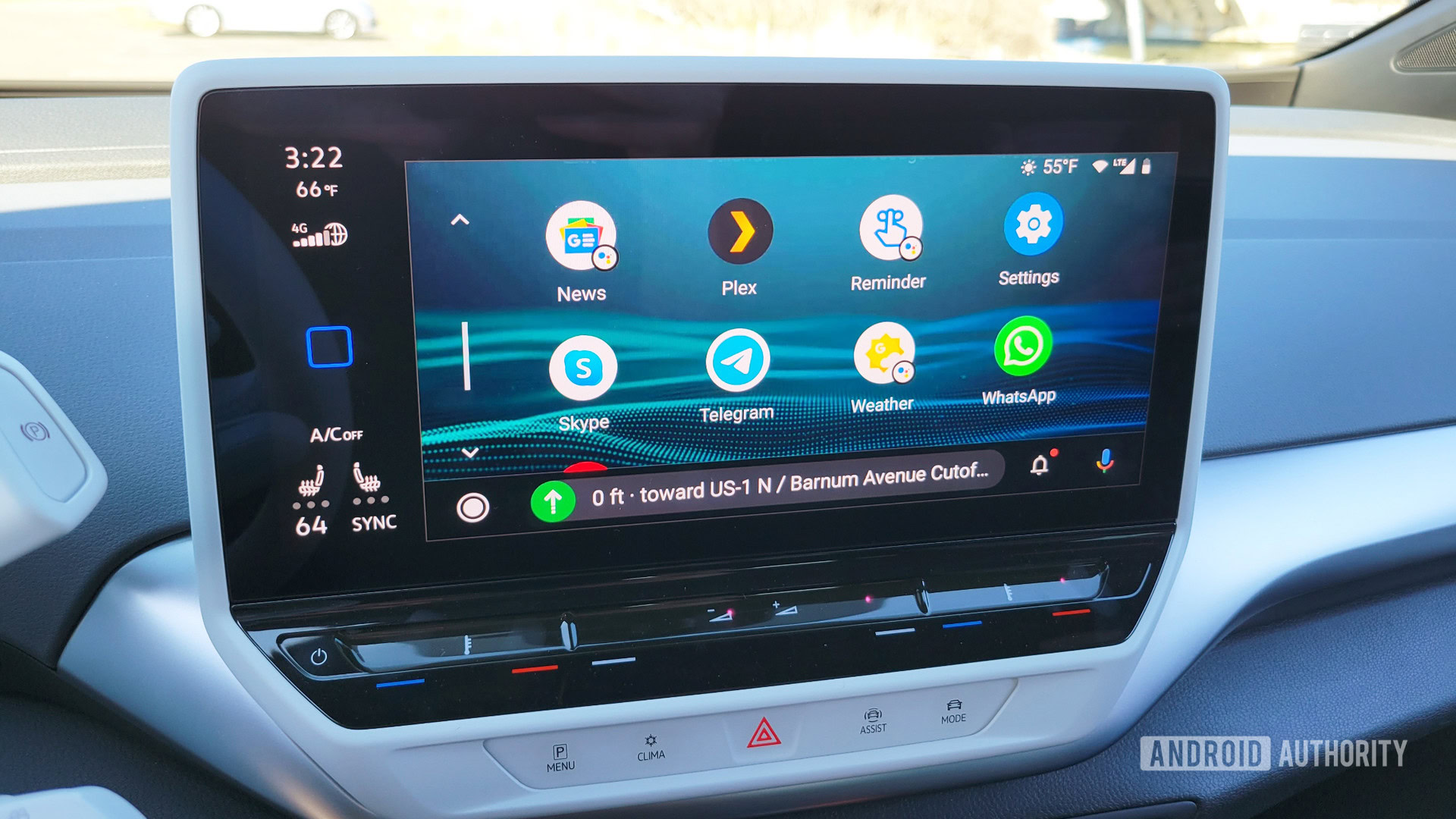
Google’s Android Auto started off with a bang in 2014. The app promised that your car’s infotainment system could communicate with your phone, and vice versa. Finally, you could make your car’s display just as powerful as the one in your pocket!
However, things didn’t go as smoothly as Google likely anticipated. Manufacturer adoption of Android Auto lagged far behind that of Apple’s own system, known as CarPlay. Even the cars that did have it faced limitations, such as a lack of wireless support and a dated interface. It wouldn’t be until 2019 that Google would finally push a UI overhaul to the system as well as some upgraded features, including wireless connections.
Related: 15 best Android Auto apps to get the most out of it
Now, things are looking back up for Google. More manufacturers than ever support Android Auto. As the years go on, there won’t be many Android smartphones that don’t work with it wirelessly out-of-the-box, either.
To check in on the status of Android Auto in 2021, I test-drove the new Volkswagen ID.4. This all-electric compact SUV has a 12-inch display that fully integrates with Android phones. The car even has a wireless charging dock in which you can store your phone while driving, giving you a fully hands-free experience while keeping your device topped up.
Volkswagen ID.4: An EV for everyone
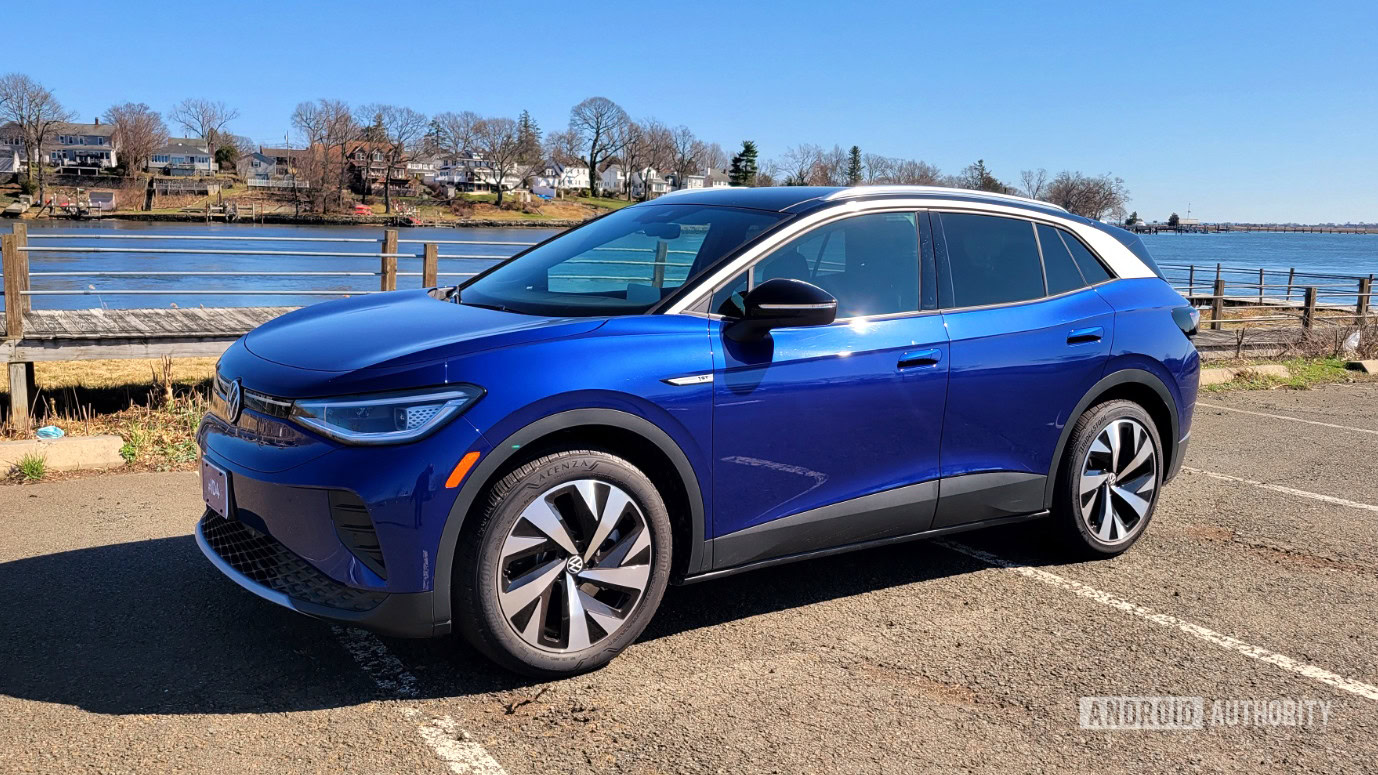
When I spoke with Volkswagen about testing the ID.4, the company made one thing exceptionally clear: it is not gunning for Tesla customers. Obviously, with how prevalent the Tesla brand is, it’s impossible for any fully electric vehicle to not be compared against it. However, the Volkswagen ID.4 is designed — and priced — to appeal to regular folks who just want a new compact SUV, regardless of whether it’s electric or not.
With all that in mind, it was unsurprising to find that the ID.4 looks, feels, and drives just like every other compact SUV I’ve used. There’s a lot more tech in here than usual and the all-electric driving takes a bit of getting used to, sure. Once I got acclimated though, it didn’t feel like I was driving the car of the future. It felt like I was driving the car of today, but better — and more environmentally friendly.
Getting behind the wheel of the ID.4 feels like driving the car of today, but better — and more environmentally friendly.
One of the biggest bits of news surrounding the ID.4 is Volkswagen’s commitment to making Android Auto a standard feature across all models and trims. Many other manufacturers offer Auto as an upgrade, which inevitably causes lots of folks to pass due to the extra cost. The standard offering with the ID.4 is a huge boon for Google as it will get Android Auto into millions of more cars. This should help give Google the impetus it needs to keep making its auto-centered app better and better.
During my time with the ID.4, I focused mostly on Android Auto and the infotainment system. Below, you’ll find a bunch of information on what you can expect with an ID.4 or most other 2021 cars with Android Auto incorporated.
The ID.4 model Volkswagen provided to me is a difficult-to-get First Edition. The regular ID.4 Pro will start at $39,995 in the United States, before tax breaks and subsidies. Depending on where you live, those incentives could knock the cost of the car down to only a little more than $30,000. Hit the link below to see all the available options.
What is Android Auto?
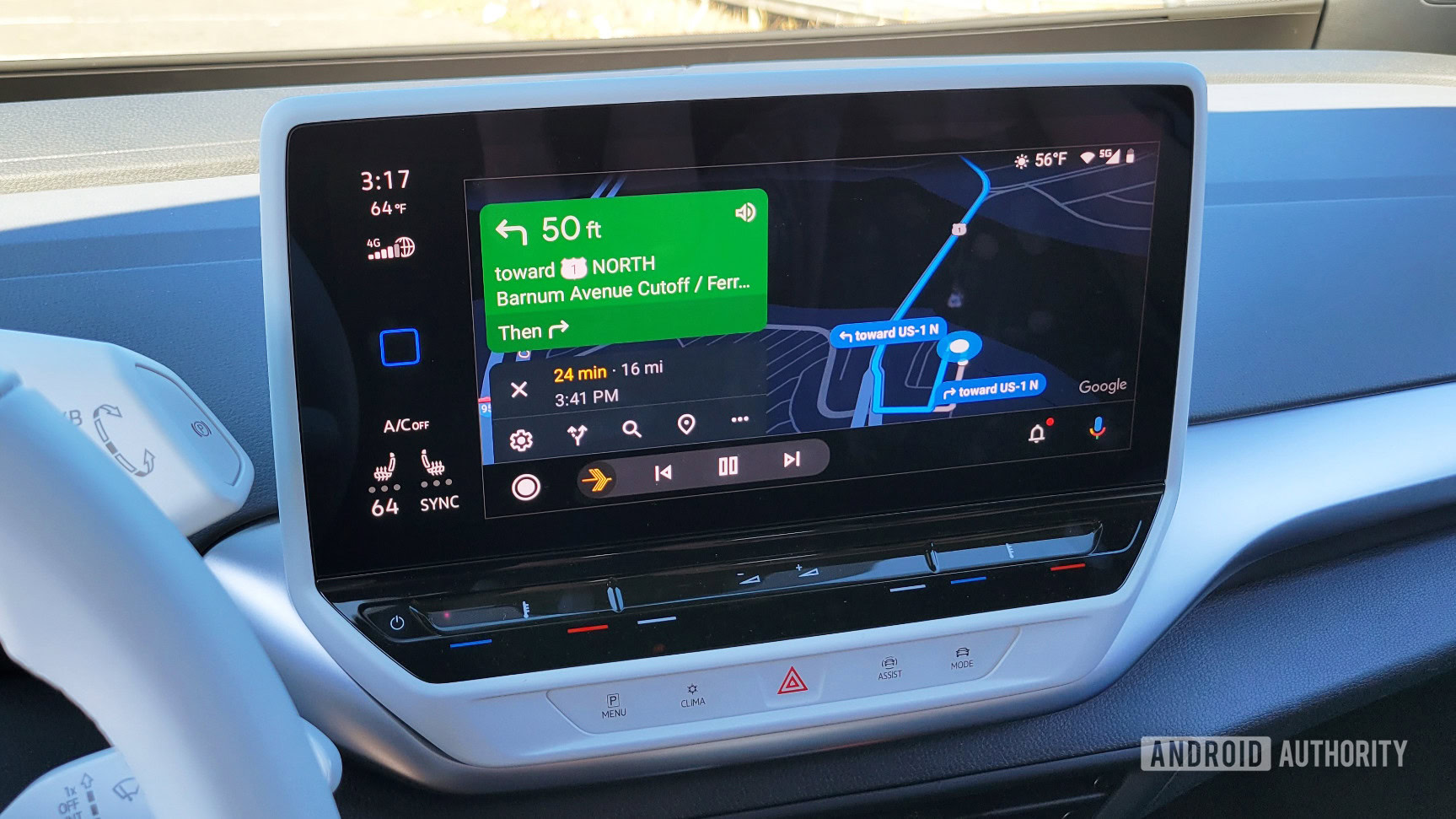
The best way to describe Android Auto is that it’s an app that gives your car’s infotainment system a way to mirror your phone’s screen. Granted, it’s more complicated than that, but that boils it down to its core reason for existing.
Once your phone and car are connected, you can access many of your phone’s apps and features right from the car’s media display. When you launch an app from the infotainment screen, it actually launches on your phone, but in the background. This allows your phone to power the apps on your media display but prevents you from needing to actually touch your phone.
See also: Please, please stop making video calls while driving
The core idea behind Android Auto is safety. Simply put, it is safer for you to tap your car’s media display a few times to launch Spotify or Google Maps than it is to fiddle with your phone while driving. As mentioned earlier, the Volkswagen ID.4 has a wireless charging dock in the center console near the cupholders. You can drop your phone into it when you get into the driver’s seat. Once you do, you can’t even see your phone’s display, much less control it.
Obviously, there are certain things Android Auto won’t let you do. For example, the system doesn’t support any video-based apps — Netflix, YouTube, Amazon Prime Video, etc. It wouldn’t be safe to watch TV and drive at the same time, after all. It doesn’t support games for the same reason, or even productivity apps like Google’s own Docs, Sheets, Slides, etc. The apps it does support revolve around music, navigation, voice-powered messaging, and audio-based information systems, such as podcasts and weather/news reports.
What is Android Auto not?
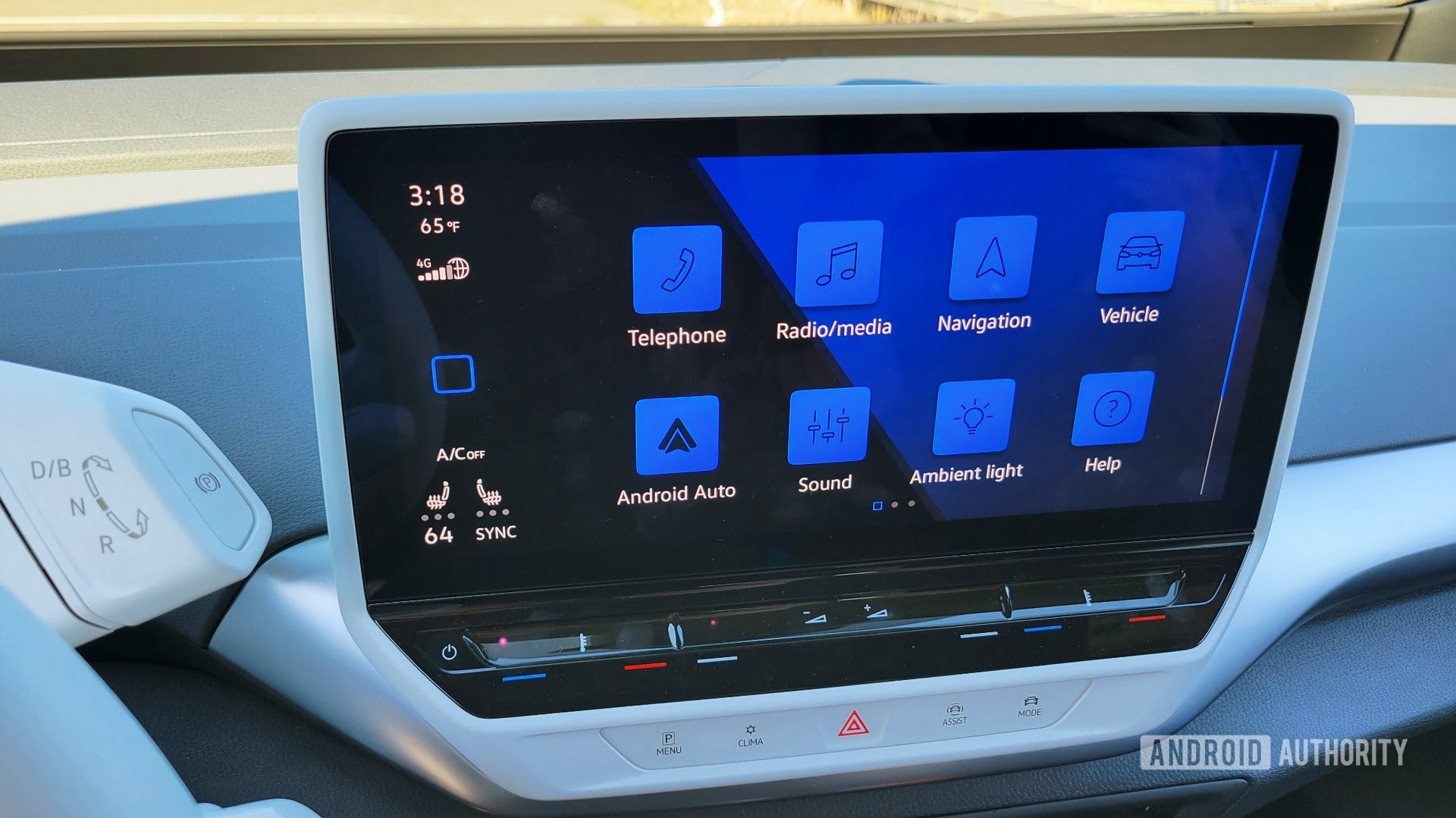
Android Auto is not your car’s dash interface. This can be a bit confusing because there are crossovers, but the two systems are very much separated.
For example, you cannot use Android Auto to control the temperature of your vehicle. You can’t turn vehicle systems on or off, such as wipers or lights. In the case of the Volkswagen ID.4 and other EVs, you can’t even check your charging/battery status, nor can you access EV charging station apps (although that will change soon).
Remember: all Android Auto does at its core is mirror your phone. That means if your phone can’t do it, neither can Android Auto.
See also: The best car chargers: A buyer’s guide
Google has a similarly named but wholly different platform called Android Automotive, introduced in 2017. This product uses a customized version of Android as the car’s “operating system.” Very few vehicles have this Automotive platform right now, but that’s going to start changing. Earlier in 2021, Ford announced a partnership with Google that would bring Automotive to millions of Ford-made cars starting in 2023. Those cars and others with the Automotive platform would have self-sustained Android apps and full integration with the vehicle’s various features. This would allow you to, for example, say, “Hey Google, open the sunroof,” and it would happen.
The Android Auto platform that appears in the ID.4 and millions of other cars at the moment, though, is a bit more limited.
Setup is a snap
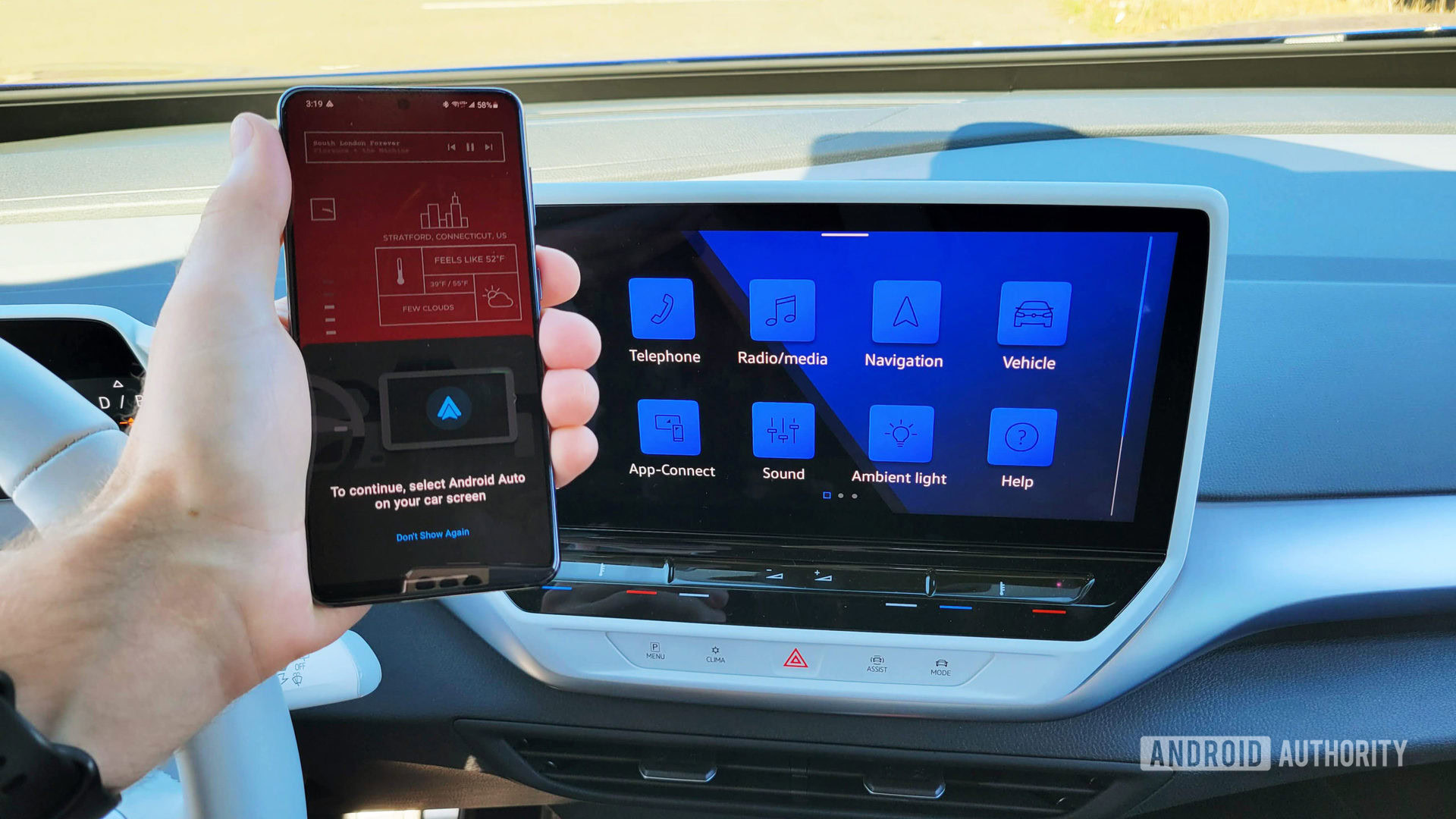
During my time with the ID.4, I connected it with my Samsung Galaxy S21. As with most modern Android phones, Android Auto comes pre-installed on the Galaxy S21 and it is capable of wireless connections with vehicles.
When you get into the car for the first time, you hit the App-Connect button on the infotainment screen. That provides you some simple instructions for connecting your phone — the usual stuff, not too dissimilar from connecting your phone’s audio and call features via Bluetooth.
Getting setup with Android Auto is easy. Once you do, it's a set it and forget it situation.
Once connected, the App-Connect button becomes an Android Auto button. Your phone will now auto-connect each time you enter the vehicle. In the case of the ID.4, connections happened pretty quickly, although it wasn’t instantaneous.
If you were using Android Auto when you last exited the car, that interface will automatically launch on the car’s display when you next enter. It defaults straight to Google Maps navigation. If you were playing music via your phone, it will automatically start playing it from where you left off.
This bevy of auto-start options allows you to literally get in the car, toss your phone into the wireless charging dock, and start driving. It’s very convenient.
It’s all about Google Assistant voice commands
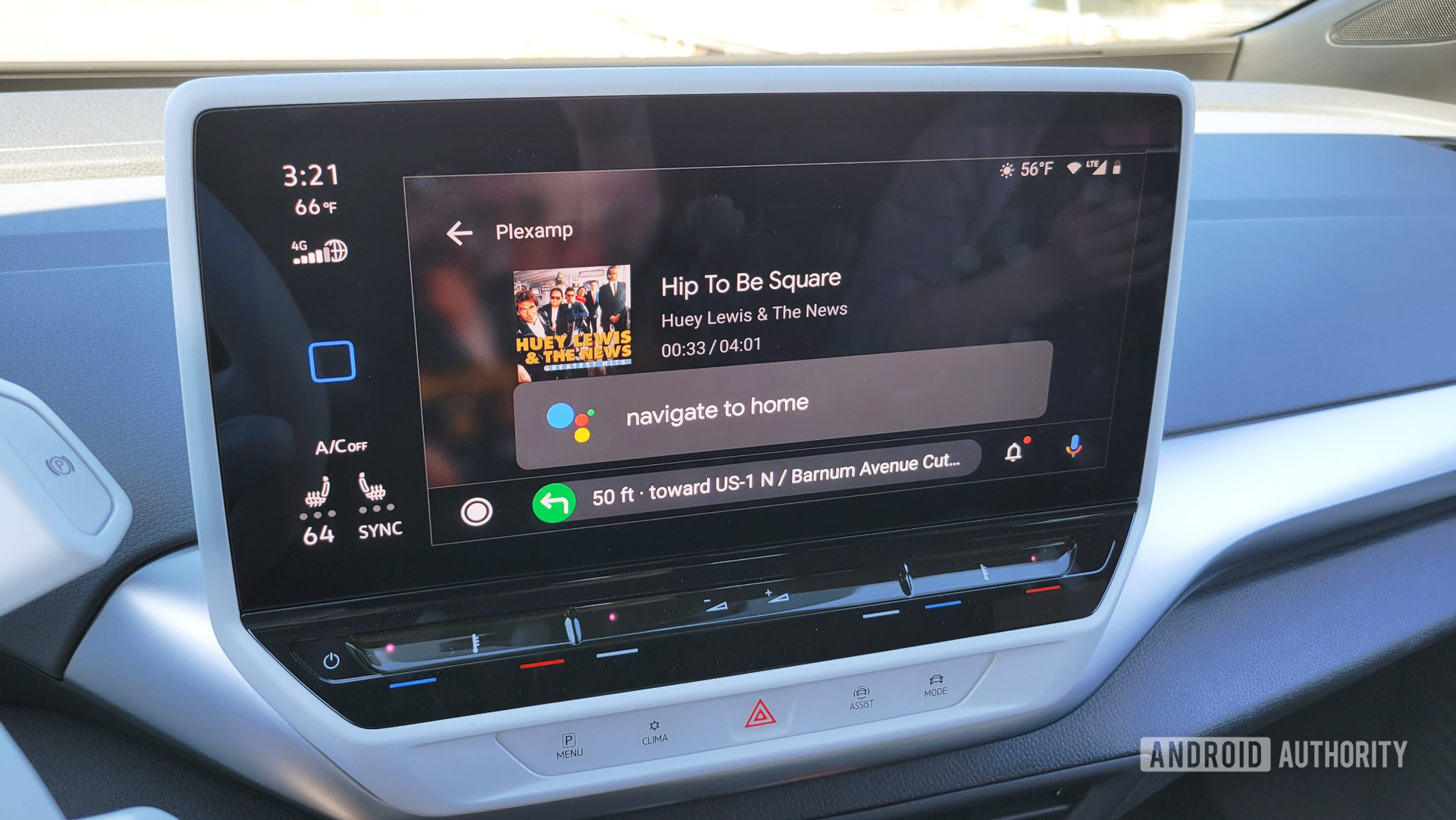
As mentioned earlier, Android Auto’s primary function is to get your phone out of your hands while you drive. However, if you’re touching your car’s media display as much as you would be touching your phone, that doesn’t really make it much safer, does it? That’s where Google Assistant comes in.
At this point, it’s difficult to imagine that Android Auto once existed without Google Assistant (Assistant is about two years younger). In the modern version of Auto, the Assistant microphone icon is in the lower-right corner at all times. Additionally, it is always listening for the “OK Google” hotword. This allows you to issue voice commands to control Android Auto features. Theoretically, there shouldn’t be many times you need to touch the media display at all.
Related: Google Assistant guide: Make the most of your virtual assistant
If you do need to touch the display, the Android Auto home button is always in the lower-left of the screen. Tapping it opens your “app drawer” of sorts, which shows you the apps on your phone that work with Android Auto. Most of the time, when you launch an app it just launches an Assistant feature. For example, tapping the Google News icon just starts an Assistant-powered readout of the day’s major news events.
If you’re the kind of person who hates voice commands or doesn’t like using Google Assistant, you’re going to have a tough time with Android Auto. However, using your voice to launch apps, ask for driving directions, conduct web searches, or even start/stop your music is what makes Android Auto so powerful (and safe!).
In the case of the Volkswagen ID.4, I didn’t have any issues with voice commands. The system heard most of them correctly, and the Snapdragon 888 in my Galaxy S21 performed those commands quickly. The only time I faced problems was with the windows down or the music way up. However, that’s just a general limitation with voice commands.
Android Auto apps: Lots missing

I have nearly 200 apps on my phone. Of those, only about a dozen support Android Auto. You can imagine my shock at this when I pulled up the available apps on the ID.4’s infotainment display.
As I said earlier, there are a lot of apps that simply have no place in Android Auto, such as video streaming apps and games. However, there are plenty of apps that could have an Android Auto version but don’t. Weather apps are a good example, as are food delivery services. Even shopping apps that work through voice commands would be cool (you can already shop on Amazon using Alexa voice commands, but not on Android Auto).
Unfortunately, the blame for this falls squarely on Google. Up until very recently, the company disallowed any third-party apps on Android Auto that didn’t fall into three very specific categories: music, maps, and messaging. In 2021, though, Google is finally opening up the doors a bit more and allowing some other categories, the most welcome of which is EV charging apps.
Thankfully, this means that Android Auto is only going to get better. However, during my time with the Volkswagen ID.4, I was stuck with a very limited set of options. Still, what was there worked well and was certainly useful.
What does Android Auto do well?
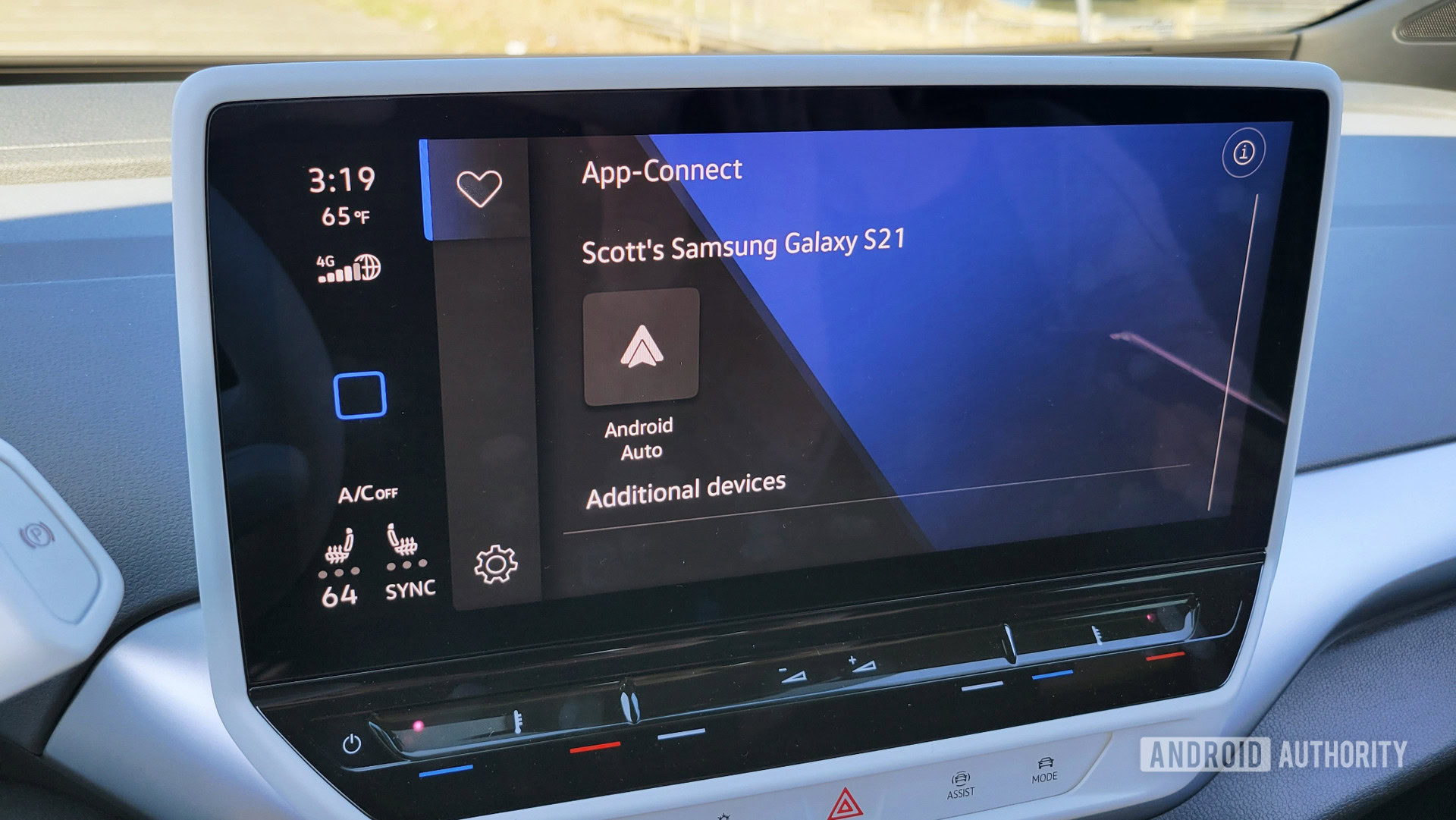
Walking away from Android Auto, the thing that left me the most impressed was how everything just worked. Once I got through the initial setup procedure, I didn’t even need to think about it anymore. I’d get into the car, start her up, and drive off. By the time I got to the end of my driveway, my music would be playing and maps would be ready for me to enter my destination.
At no point during my week with the Volkswagen ID.4 did I experience a loss in wireless connectivity with Android Auto. My voice commands all worked (aside from the times when it was too noisy). Navigating around the interface was simple and self-explanatory.
The best thing about Android Auto is that it works as expected. That might not seem like a big deal, but this is Google we're talking about!
This might all sound boring, but this is Google we’re talking about. Two wholly different systems communicating well with very little work on my part is not the norm for Google. Additionally, from what I have heard, this is not how Android Auto has always been historically. This was my first time ever using Auto, so I can’t speak for older iterations.
Although the system is missing a ton of features and apps it could — and probably should — have, Google has nailed the base elements of Android Auto. That’s definitely an achievement and makes me optimistic for the future. If all Google needs to do is make the base-level experience better and more capable, that’s a lot easier than what it needed to do from 2014 to 2019, which is make it actually work as promised.
What about Android Auto needs work?
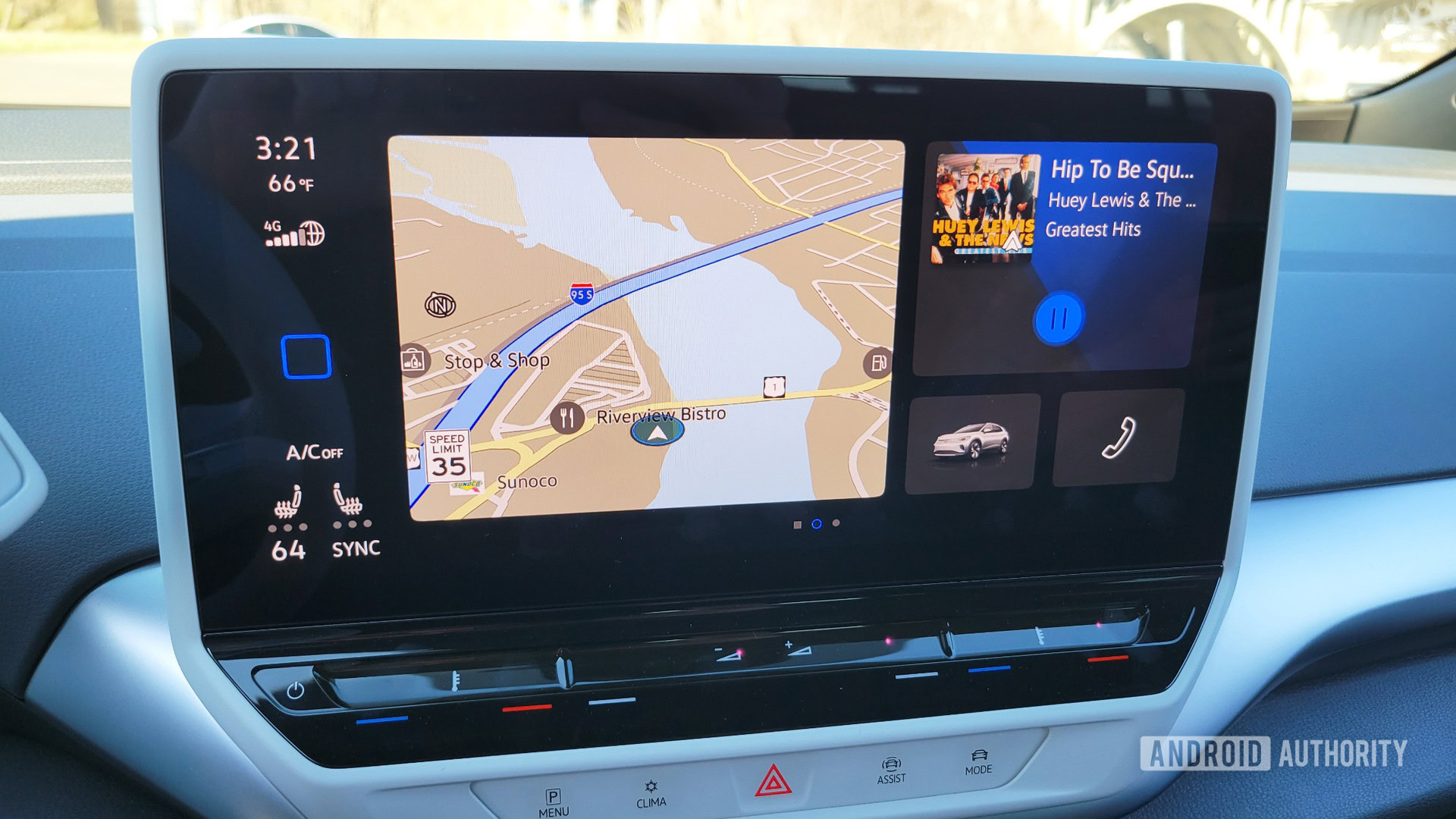
One thing that left me irritated with Android Auto was its poor use of screen real estate. Above, you’ll see Volkswagen’s layout for its own dash system within the ID.4. You’ve got VW’s maps app on the left, and then three smaller widget-esque features on the right. This makes way more sense to me than covering the entire display with one app and then having a small widget underneath for a secondary app.
Granted, Android Auto does support split-screen functionality. However, it is a very new feature that my ID.4 didn’t have yet.
More customization options and better use of screen real estate are the areas where Auto needs some work.
Another thing I’d like to see improved is more customization options. Auto has a way for you to choose wallpaper to better match your vehicle’s interior, which is nice. However, you can only choose it from a selection of wallpapers that look like they were designed in the 1990s. There’s also no way to control things like setting a permanent dark mode.
Finally, I did have some issues with notifications. The little red dot on the notification bell would be there, but when I’d open notifications, there’d be an old alert I had swiped away long ago. I’d check my phone, but there’d be no notifications there. This is likely a minor bug, but it is proof that Google hasn’t ironed out all the kinks quite yet.
Android Auto in 2021: I’m glad this came as standard
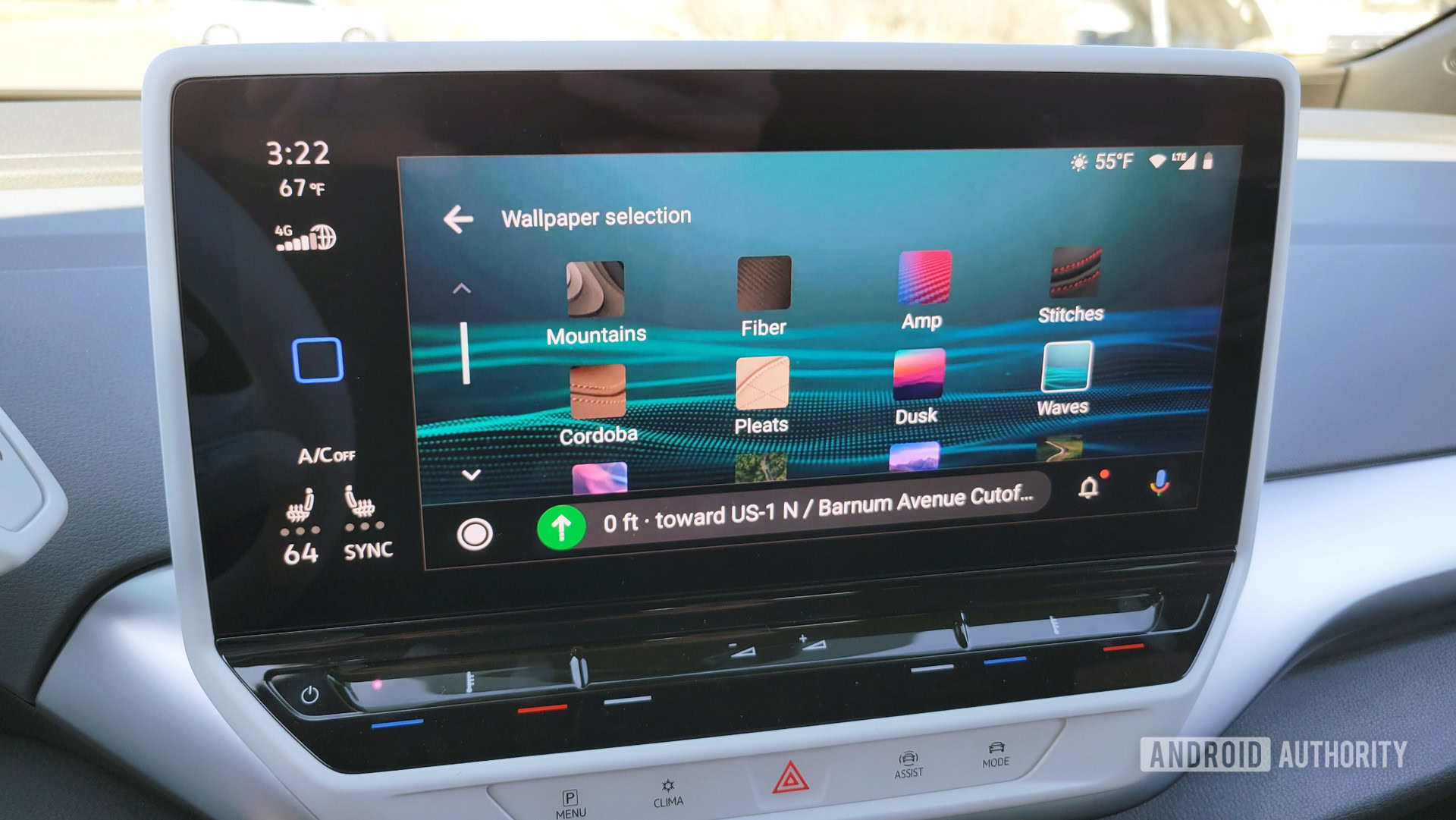
Earlier in this article, I mentioned that Android Auto is usually a paid upgrade in a lot of vehicles. With the Volkswagen ID.4, that’s not the case — every model will have it without any extra charge to the buyer.
After spending time with the ID.4, I couldn’t help but feel paying extra for Auto would be a wasteful expenditure. Granted, car manufacturers tend to bundle Android Auto and CarPlay with other perks, such as larger displays, cameras, sound systems, etc., so you’re usually not just paying for Auto/CarPlay. But it’s clear that, as useful as Auto is, it’s not revolutionary enough to warrant a paid upgrade that can head into the four-figures with some OEMs.
Paying extra for Android Auto wouldn't really be worth it, so the fact that the ID.4 has it as standard is a nice gesture.
Volkswagen’s made the right move here by making it standard. It’s a welcome addition to the driving experience that works well and has value. It just doesn’t have a value that I would pay hundreds for over the normal cost of the vehicle.
That all being said, with the way Android Auto is right now, it probably shouldn’t be a deciding factor for your vehicle purchase. It’s convenient, dependable, and intuitive, but it’s also pretty simplistic. Google could bring a lot of advancements to it in the future, but that’s not a guarantee, so it would be unwise to add too much weight to Auto being included or not included with your next car.
The future: What could Android Auto become?
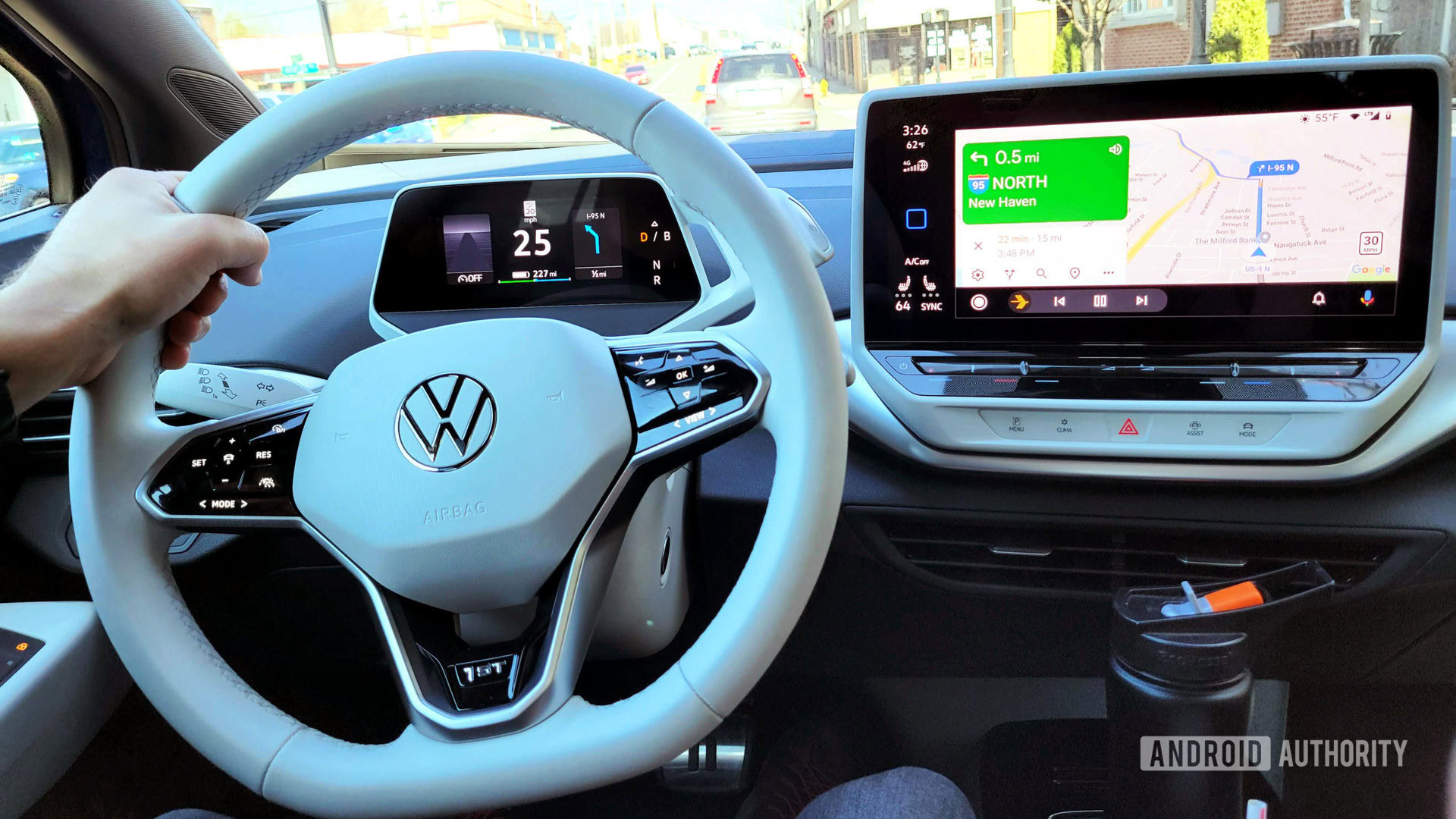
Interestingly, Google has already taken the next logical step for Android Auto, which is the introduction of Android Automotive. The latter system promises full integration with the car itself, which is something Auto can’t offer — and likely won’t ever.
This conundrum becomes even more apparent the more you use Google Assistant. At home, I use Assistant for everything: turning on the lights, setting the temperature, starting my robot vacuum, and on and on. When I’m in the car, it makes logical sense to me to say, “Hey Google, set the temperature to 68 degrees.” Doing so with Android Auto, though, changes my Nest Thermostat at home, which is hardly ideal.
Android Auto is not the future. Android Automotive is.
Still, Google could get Android Auto to at least integrate a little bit more with vehicles. In the Volkswagen ID.4, the driver’s display behind the steering wheel gives me very basic driving instructions from my Google Maps app. That means the steering display and the main display are working together, even though the steering display obviously doesn’t have Android Auto. Google could investigate more ways to integrate Auto with cars such as this, which would make the system even more powerful.
Ultimately, though, I feel like Android Auto’s days are numbered. In 2023, we’re going to get an influx of cars running the full Android Automotive system which won’t require a phone to work and will fully integrate with the vehicle. Ford, Lincoln, Nissan, Mitsubishi, and more automotive groups are already prepping Automotive-based cars. If Google can make Automotive into the system we all dreamed of when we first heard about Android Auto, there wouldn’t be much need for Auto anymore.
Granted, it will take years for Automotive to proliferate enough to end Android Auto. In the meantime, Auto works as one would expect. It probably shouldn’t be the lynchpin of your car-buying decision, but it’s a nice perk to have.